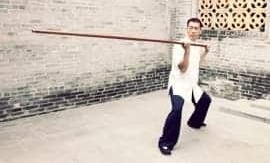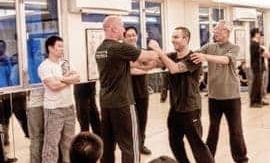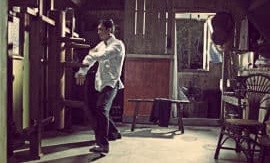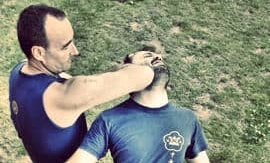
SIFU BEN DER WAS ATTENDING ST. FRANCIS XAVIER COLLEGE IN HONG KONG WHEN HE BEGAN TO STUDY WING CHUN IN 1958. IN THIS EXCLUSIVE INTERVIEW, HE DETAILS HIS TIME AS AN IP MAN STUDENT AND TALKS ABOUT HIS EXPERIENCE GROWING UP WITH BRUCE LEE IN HONG KONG, AS WELL AS BEING HIS TRAINING PARTNER IN SAN FRANCISCO. LAST, HE OPENS UP ABOUT WHY HE CHOSE TO GIVE UP HIS OWN SCHOOL TO FOLLOW SIFU KENNETH CHUNG IN THE LEUNG SHEUNG LINEAGE.
What makes you love Wing Chun so much?
Simplicity is the key to brilliance. I love Wing Chun because we strive to make things simple. I also believe the world needs coaches that lead successful people to greater success and coaches that help unfortunate people see hope in life. Wing Chun is one of such vehicles.
Something many don’t know about you is that you began Wing Chun at Grandmaster Ip Man’s school in Hong Kong. Can you tell us what it was like?
I started under Ip Man in 1958, when he was teaching out of his apartment at the Lei Cheng Uk Estate. I would get out of school around 3pm and train there every day until dinnertime. Ip Man was having health and financial issues and was at a low point in his life after his wife passed away. Sihing Ng Chan and Chow Tze Chuen were leading classes, while Ip Man would correct us. The students were either from the Kowloon Motor Bus Company or from my high school, St. Francis Xavier College.
What are your most memorable moments when you were training at Grandmaster Ip Man’s school?
The Lei Cheng Uk Estate is a low-income housing project. Violence frequently occurred in public areas, and dark hallways were occupied by drug dealers. Many stories of Ip Man “taking care of himself” and supporting the neighbours came from this place. As teenagers, we were scared to walk by ourselves. The entire time, I lied to my mother that I was staying after school for math tutoring.
What initially drew you to Wing Chun?
Growing up in Hong Kong, I was a happy kid. My family owned a multi-story building at Kowloon Sham Shui Po District, where we lived in the penthouse. We had a 1000 sq. ft. patio where my mom would let me host dance practices every weekend. Because my schoolmates were into Wing Chun, we would occasionally have guests, like Wong Shun Leung and William Cheung. After a while, I just went into Wing Chun.
Another fact many are interested in is your friendship with Bruce Lee. What was it like attending St. Francis Xavier College in Hong Kong with him? I heard you and Bruce would go Cha Cha dancing. Can you tell us about any other experiences you guys had together?
Bruce Lee was quite popular in Hong Kong at the time, making movies and running all over the places, so other than those Cha Cha dance gatherings, I couldn’t catch him often. However, when we both landed in San Francisco within the same week in 1959, there was a period of six months when we were living at Chinatown’s Jackson Street and attending English classes. We would practise Chi Sau together a lot. I learned a lot of his tricks.
In 1968, approximately ten years after you began Wing Chun under Grandmaster Ip Man, you changed your approach when you met Kenneth Chung. What was so unique about Kenneth Chung’s hands when you guys first worked out together that it would cause you to change your approach?
First, I would like to clarify that, despite starting my Wing Chun training under Ip Man, I do not wish to promote myself under the legendary Grandmaster, due to my belief that only his senior disciples, such as Leung Sheung and Lok Yiu, could and should. Sifu Kenneth Chung, despite being seven years younger than me and barely 20 years old when we first met, opened my eyes to Wing Chun. Prior to meeting Kenneth, I had my own school at San Francisco Chinatown’s Bush Street with about ten students. But after meeting Kenneth in September 1968, on the second day after he landed in America, I was impressed with this young gentleman’s techniques and knowledge of Leung Sheung Wing Chun principles, so I converted to the Leung Sheung lineage right away. In Gung Fu, there is a saying: “Seniority is not based on start date but accomplishment.”
Having trained under the Leung Sheung lineage for the last 50 years, what defining characteristics does Leung Sheung Wing Chun have when compared to other Wing Chun methods?
Through Sifu Kenneth, I was introduced to the late Leung Sheung in 1976. I respect the man a lot. Sifu Leung Sheung shared a lot of his insights with me. He didn’t want his students to drill blindly on fixed routines. He would feed “random attacks” to his students, so they can relate to the opponent’s movement and energy. Being also an accomplished practitioner of Dragon Style and Choy Li Fut, he gave us pointers on how to deal with them using Wing Chun. Most importantly, Leung Sheung was big into “Core Structure” and “Functional Energy.”
Having trained with Kenneth Chung since 1968, what makes your relationship seem to work so well?
Sifu Kenneth Chung, as he humbly asks everyone to call him Ken, did not TEACH but helped me EXPLORE myself. The first advice Ken gave me was: “Follow me but don’t copy me.” While Ken was into practising what’s right for his physique, he advised me to focus on agility and mobility for being someone of smaller stature and led me to take the similar learning path of Ip Man or Leung Bik. After nearly 50 years of training together almost every week, we continue to re-examine the Wing Chun curriculum and conclude that we are after the fundamentals. When one understands the fundamentals, one understands all training methods and technical interpretations.
What are your thoughts on the current calibre of Wing Chun teachings?
A lot of Westerners have become very accomplished instructors and in many areas do an even better job than their Asian counterparts. Looking into the course of Wing Chun development, I think the mountain to climb after “Technical Proficiency” (型) will be the mountain of “Mental Insight” (意), i.e., is the teacher passing on the right analytical skills to his students to look beyond merely the physical techniques? Finally, after the concerns of “Practicality” and “Simplicity” are addressed, the teacher needs to present a “Sustainable Path with Meaningful Purpose”, i.e., “The Tao” (道), to the students, so they can become an “Artist of Life.” For my purpose, I want people to better themselves and have a smile on the face.
Many nowadays fall into two categories: preservationist or progressivist. The preservationists believe the only correct approach is to practice the way Grandmaster Ip Man did, while the progressivists believe Wing Chun should be ever-evolving. What category would you consider yourself to fall into and why?
I’m a preservationist on the core principles, yet a progressivist on applications. Over the course of a student’s journey, I immerse him or her with an increasing number of details on the original form and conditioning exercises. The “Core Structure” can only be experienced by rigidly adhering to the classical forms, as passed down from our ancestors. The outcome of that is “Functional Energy”, which is formless. Acquire the form, seek the formless. Learn the way, find your own way.
Do you have any advice for younger generations of Wing Chun practitioners?
Work on it!



















